















Honda Gold Wing |
|---|
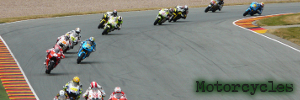
|
| Topic Navigation |
|---|
|
Wikipedia: Honda Gold Wing
Page Sections History Photographs Merchandise |
History
The following section is an excerpt from Wikipedia's Honda Gold Wing page on 18 September 2018, text available via the Creative Commons Attribution-ShareAlike 3.0 Unported License.
The Honda Gold Wing is a series of touring motorcycles manufactured by Honda. Gold Wings feature shaft drive, and a flat engine. Introduced at the Cologne Motorcycle Show in October 1974, the Gold Wing went on to become a popular model in North America, Western Europe and Australia, as well as Japan.
In 1972, following the success of the ground-breaking CB750 superbike, the company assembled an R&D design team to explore concepts for a new flagship motorcycle. The project leader was Shoichiro Irimajiri, who in the 1960s had designed Honda’s multi-cylinder MotoGP engines and their Formula One V12 engine.
Simultaneously, at the 1972 Tokyo show, Honda revealed the CVCC "clean-burn" car engine, their first production liquid-cooled engine. (Soichiro Honda was allegedly unconvinced that liquid-cooling was superior to air-cooling, but younger engineers eventually prevailed).
The 1974 Gold Wing with its flat-four shaft-drive powertrain used technologies both from earlier motorcycle and automotive designs.
Although preceded by the 1971 water-cooled Suzuki GT750 two-stroke triple, the Gold Wing was the first Japanese production motorcycle with a water-cooled four-stroke engine. The first four-cylinder boxer engine was produced in 1900.
During its development, the CB750 was known within Honda as their "King of Motorcycles"; so Honda's next big thing would be deemed the "King of Kings". Honda first envisaged the Gold Wing as a large sport motorcycle, but on learning that customers were "piling miles on touring", Honda reconsidered the bike’s design objectives, realising that the primary market for the Gold Wing was the long-distance motorcyclist. In North America a motorcycle suitable to that task would need comfort for the long haul, wind protection, a smooth ride, a comfortable seat, luggage storage, and power in abundance.
In American in the early 1970s, long-distance motorcyclists had only a few manufacturers to choose from: Harley-Davidson, Moto Guzzi and BMW. The H-D Electra Glide was a comfortable, high-maintenance and high-vibration bike with a loyal cult following. It faced strong competition from Moto Guzzi's 850cc Eldorado. BMW motorcycles were smoother and more reliable, if expensive. Other large Japanese bikes, such as the Honda CB750 and the Kawasaki Z1 were cheaper but were not ideal tourers with their small fuel tanks and rear drive-chains needing regular maintenance. The Gold Wing was aimed at a newly-emerging market segment namely, a new kind of American long distance rider not likely to buy a Harley or BMW but who would open their wallets for an affordable machine offering comfort, endurance, low-maintenance and a smooth, torquey, quiet engine.
The Gold Wing's secondary target market was Europe, where riders prioritised handling and performance over luxury. (The European market's special demands subsequently led to the Honda Pan European).
In 1972, the project team broke from Honda practice to produce an experimental prototype motorcycle, code-named "M1". Instead of the usual transverse engine layout with a chain final drive, the M1 had a longitudinal engine suitable for shaft drive. The M1 had a 1470cc liquid-cooled flat-six engine, (twice the displacement of the CB750). Instead of seeking high performance (as some engineers had wanted) the M1 engine was designed to have a broad torque output and to produce 80 horsepower (60 kW) at 6700 rpm, with a top speed of 220 kilometres per hour (140 mph).
The brainstorming team's M1 project was never intended as a production prototype. Nonetheless, the M1 should be seen as the primordial Gold Wing because so many of its distinctive features appeared on the GL1000. The flat-six gave the M1 a low center of gravity, enhancing stability, but the extreme length of the engine/gearbox unit resulted in a cramped riding position. Instead, the project team chose to build a bike with a compact one liter flat-four engine. This bike was code-named "Project 371", and Toshio Nozue (who had worked on CB750 development) took over from Irimajiri as project leader.
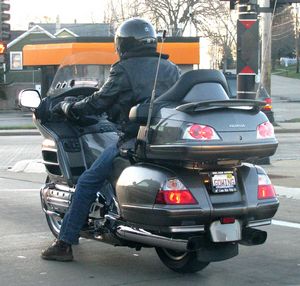 |
Photo ©2011 Bill Crittenden
View photo of Honda Gold Wing - 1,979KB |
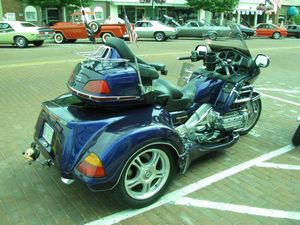 |
Trike Photo ©2011 Bill Crittenden The Cars Time Forgot Car Show View photo of Honda Gold Wing Trike - 2,985KB |
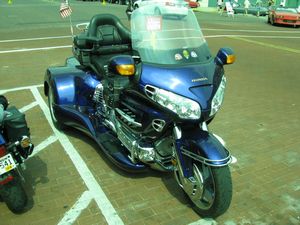 |
Trike Photo ©2011 Bill Crittenden The Cars Time Forgot Car Show View photo of Honda Gold Wing Trike - 2,625KB |
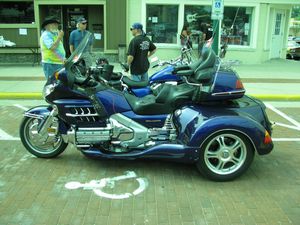 |
Trike Photo ©2011 Bill Crittenden The Cars Time Forgot Car Show View photo of Honda Gold Wing Trike - 2,869KB |
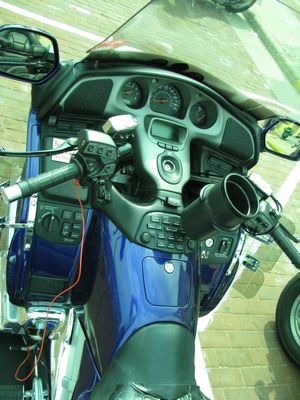 |
Trike Photo ©2011 Bill Crittenden The Cars Time Forgot Car Show View photo of Honda Gold Wing Trike - 2,867KB |
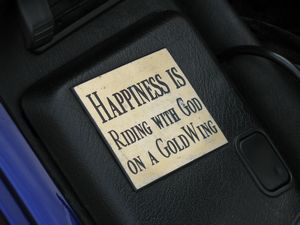 |
Trike Photo ©2011 Bill Crittenden The Cars Time Forgot Car Show View photo of Honda Gold Wing Trike - 688KB |
| Type & Item # | Name | Details |
|---|---|---|
| Model Kit - Fujimi 15103 | Honda GL 1100 Gold Wing | Naked Motor Cycle Series (2), 1:15 scale |
